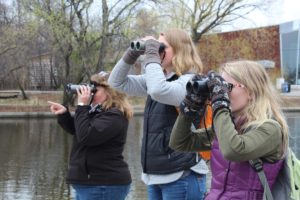 Our Spring banding season started off with Part 2 of our Bird Banding Workshop on April 27th and 28th. We had very poor weather (snow) and only caught a handful of birds. Luckily we were able to do some practicing inside and we all learnt quite a bit!
Our Spring banding season started off with Part 2 of our Bird Banding Workshop on April 27th and 28th. We had very poor weather (snow) and only caught a handful of birds. Luckily we were able to do some practicing inside and we all learnt quite a bit!
Don’t worry if you missed our banding workshop! We will be having another one in November.
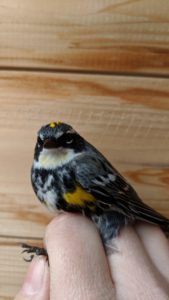 Again, due to poor weather the first few days after the workshop weren’t very fruitful. Our patience with the weather, however, was rewarded with a wave of warblers! Wednesday, May 8th we banded 139 birds in two hours. 85 of those birds were Myrtle Warblers. It was BANANAS!
Again, due to poor weather the first few days after the workshop weren’t very fruitful. Our patience with the weather, however, was rewarded with a wave of warblers! Wednesday, May 8th we banded 139 birds in two hours. 85 of those birds were Myrtle Warblers. It was BANANAS!
This year our Bander in Charge is once again, the lovely Kelsey Bell. She will be banding Mondays, Wednesdays, Fridays, Saturdays, and Sundays for the month of May. Feel free to stop by to say hello and see some bird banding in action! Banding has also picked up since May 8th and is getting more exciting every day.
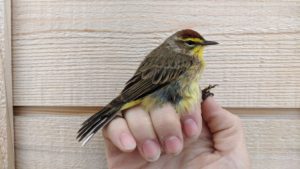 This year we are once again participating in The Great Canadian Birdathon! Our Birdathon day was May 12th and it was absolutely amazing! We have a list of 177 different species from 10 different locations. Two of those locations were in Ontario: Rondeau Provincial Park and Point Pelee. Some highlights included a Blue-headed Vireo, Prothonotary Warbler, Northern-rough Winged Swallow, Upland Sandpiper, Mountain Bluebird, and several other species of warblers, shorebirds, and birds of prey!! Check out our species list below.
This year we are once again participating in The Great Canadian Birdathon! Our Birdathon day was May 12th and it was absolutely amazing! We have a list of 177 different species from 10 different locations. Two of those locations were in Ontario: Rondeau Provincial Park and Point Pelee. Some highlights included a Blue-headed Vireo, Prothonotary Warbler, Northern-rough Winged Swallow, Upland Sandpiper, Mountain Bluebird, and several other species of warblers, shorebirds, and birds of prey!! Check out our species list below.
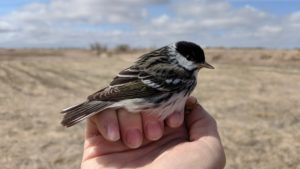 So, thanks to our volunteers the Birdathon birding day was a complete success but we haven’t reached our fundraising goal yet. But don’t worry there is still time to donate! Check out our fundraising page, donate and show your support!!
So, thanks to our volunteers the Birdathon birding day was a complete success but we haven’t reached our fundraising goal yet. But don’t worry there is still time to donate! Check out our fundraising page, donate and show your support!!
Help us help birds!
https://www.canadahelps.org/s/v47rz
Birdathon Species Lists
| MANITOBA | ONTARIO |
| · Greater White-fronted Goose
· Snow Goose · Ross’s Goose · Canada Goose · Tundra Swan · Wood Duck · Gadwall · Mallard · Blue-winged Teal · Northern Shoveler · Northern Pintail · Green-winged Teal · Canvasback · Redhead · Ring-necked Duck · Lesser Scaup · Bufflehead · Common Goldeneye · Hooded Merganser · Common Merganser · Ruddy Duck · Ruffed Grouse · Sharp-tailed Grouse · Horned Grebe · Red-necked Grebe · Western Grebe · American White Pelican · Double-crested Cormorant · American Bittern · Great Blue Heron · Turkey Vulture · Osprey · Bald Eagle · Northern Harrier · Cooper’s Hawk · Broad-winged Hawk · Swainson’s Hawk · Red-tailed Hawk · American Kestrel · Merlin · Sora · American Coot · Sandhill Crane · Semipalmated Plover · Killdeer · American Avocet · Spotted Sandpiper · Solitary Sandpiper · Greater Yellowlegs · Willet · Lesser Yellowlegs · Upland Sandpiper · Marbled Godwit · Least Sandpiper · White-rumped Sandpiper · Short-billed Dowitcher · Long-billed Dowitcher · Wilson’s Snipe · American Woodcock · Wilson’s Phalarope · Franklin’s Gull · Ring-billed Gull · Forster’s Tern · Rock Dove · Mourning Dove · Great Horned Owl · Boreal Owl · Eastern Whip-poor-will · Ruby-throated Hummingbird · Belted Kingfisher · Yellow-bellied Sapsucker · Downy Woodpecker · Hairy Woodpecker · Northern Flicker · Pileated Woodpecker · Least Flycatcher · Eastern Phoebe · Blue-headed Vireo · Bluejay · Black-billed Magpie · American Crow · Common Raven · Horned Lark · Tree Swallow · Purple Martin · Northern Rough-winged Swallow · Barn Swallow · Cliff Swallow · Black-capped Chickadee · White-breasted Nuthatch · Brown Creeper · House Wren · Golden-crowned Kinglet · Ruby-crowned Kinglet · Mountain Bluebird · Swainson’s Thrush · Hermit Thrush · American Robin · European Starling · Yellow-rumped Warbler · Ovenbird · Northern Waterthrush · Black-and-white Warbler · Orange-crowned Warbler · Nashville Warbler · Common Yellowthroat · American Redstart · Cape May Warbler · Yellow Warbler · Blackpoll Warbler · Palm Warbler · Wilson’s Warbler · American Tree Sparrow · Chipping Sparrow · Clay-colored Sparrow · Vesper Sparrow · Savannah Sparrow · Song Sparrow · Lincoln’s Sparrow · Swamp Sparrow · White-throated Sparrow · Harris’s Sparrow · White-crowned Sparrow · Dark-eyed Junco · Rose-breasted Grosbeak · Red-winged Blackbird · Western Meadowlark · Yellow-headed Blackbird · Brewer’s Blackbird · Common Grackle · Brown-headed Cowbird · House Sparrow · House Finch · Pine Siskin · American Goldfinch
|
· Mute Swan
· Greater Scaup · Lesser Scaup · Common Merganser · Red-breasted Merganser · Wild Turkey · Common Loon · Double-crested Cormorant · Great Blue Heron · Great Egret · Killdeer · Lesser Yellowlegs · Ring-billed Gull · Herring Gull · Common Tern · Mourning dove · Eastern Screech-Owl · Ruby-throated Hummingbird · Red-headed Woodpecker · Red-bellied Woodpecker · Northern Flicker · Willow Flycatcher · Great Crested Flycatcher · Eastern Kingbird · Warbling Vireo · Blue Jay · Tree Swallow · Barn Swallow · Tufted Titmouse · Red-breasted Nuthatch · House Wren · Carolina Wren · Veery · Wood Thrush · Gray Catbird · Brown Thrasher · European Starling · Blue-winged Warbler · Prothonotary Warbler · Tennessee Warbler · Cape May warbler · Northern Parula · Magnolia Warbler · Bay-breasted Warbler · Blackburnian Warbler · Chestnut-sided Warbler · Black-throated Blue Warbler · Pine Warbler · Black-throated Green Warbler · Canada Warbler · Eastern Towhee · Field Sparrow · Scarlet Tanager · Northern Cardinal · Rose-breasted Grosbeak · Orchard Oriole · Baltimore oriole · House Sparrow · American Goldfinch · Blue-Gray Gnatcatcher
|


 Simply put, this Fall banding season has been epic. From our very first Mourning Dove to our final bird, it has been a complete roller coaster ride. The last two weeks were a bit of a waiting game. We had been waiting for those late arrivals to bring our species total to an even 70. We were banking on Chickadees and Tree Sparrows to help us out but alas the Chickadees evaded us and the Tree Sparrows hadn’t even arrived yet! Luckily for us, we caught some weirdos.
Simply put, this Fall banding season has been epic. From our very first Mourning Dove to our final bird, it has been a complete roller coaster ride. The last two weeks were a bit of a waiting game. We had been waiting for those late arrivals to bring our species total to an even 70. We were banking on Chickadees and Tree Sparrows to help us out but alas the Chickadees evaded us and the Tree Sparrows hadn’t even arrived yet! Luckily for us, we caught some weirdos.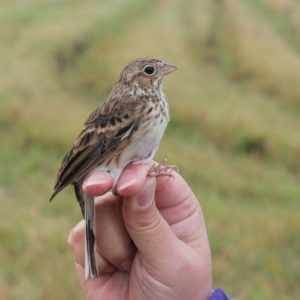 Since our record breaking Cape May Warbler we managed to catch 6 more species including a Blue Jay, Vesper Sparrow, Brown Creeper, Gray-cheeked Thrush, Golden-crowned Kinglet, and Swainson’s Thrush. Bringing our grand total to 71 species!! It’s just nutty!
Since our record breaking Cape May Warbler we managed to catch 6 more species including a Blue Jay, Vesper Sparrow, Brown Creeper, Gray-cheeked Thrush, Golden-crowned Kinglet, and Swainson’s Thrush. Bringing our grand total to 71 species!! It’s just nutty!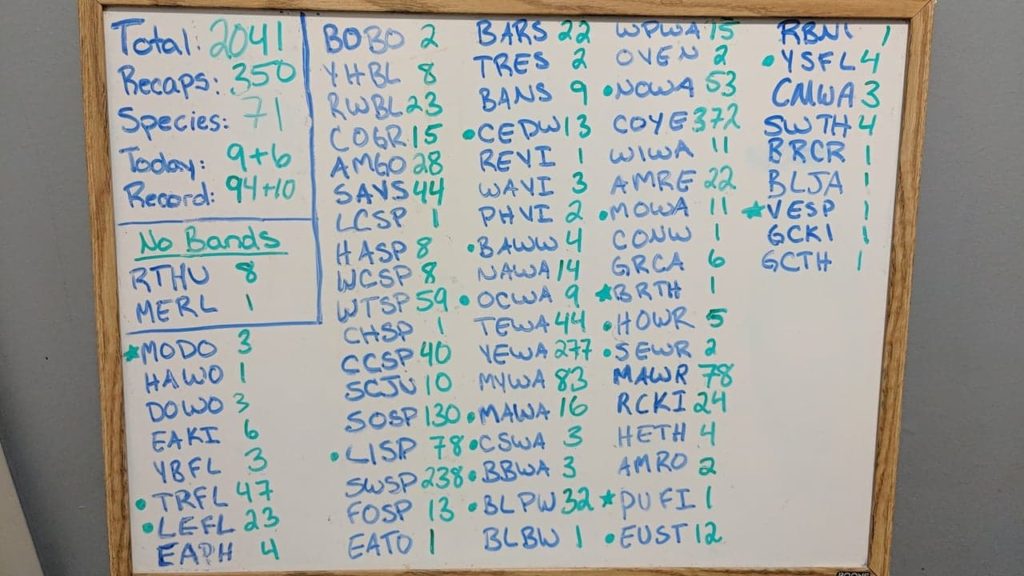 Here is a little recap of our season but be sure to check out our final list and numbers when it’s up on the website. I’ve also included our final whiteboard of the season. See if you can decipher the four letter codes for each bird!
Here is a little recap of our season but be sure to check out our final list and numbers when it’s up on the website. I’ve also included our final whiteboard of the season. See if you can decipher the four letter codes for each bird! ‘Tis the season! For breaking records that is! Since our last post we have caught more Blackpoll Warblers, Trail’s Flycatchers, and Black-and-White Warblers than in previous years. Not only that, we actually broke the species record! Our 65th species was a lovely adult male Cape May Warbler.
‘Tis the season! For breaking records that is! Since our last post we have caught more Blackpoll Warblers, Trail’s Flycatchers, and Black-and-White Warblers than in previous years. Not only that, we actually broke the species record! Our 65th species was a lovely adult male Cape May Warbler.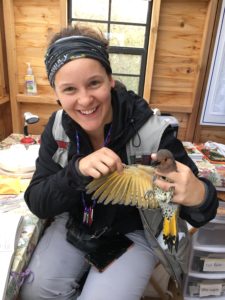 What a treat! One of our more recent moments of excitement came from a Northern Flicker. It’s always so much fun when a heavy weight hits the net! This Flicker in particular was a female and she had plenty to say. We could barely hear each other over her chatter!
What a treat! One of our more recent moments of excitement came from a Northern Flicker. It’s always so much fun when a heavy weight hits the net! This Flicker in particular was a female and she had plenty to say. We could barely hear each other over her chatter!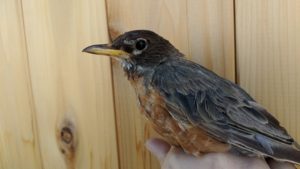 banded in 2016 and she was aged as an ‘after second year’ which means she’s at least 4 years old. Pretty impressive especially with the amount of Merlins and hawks around the marsh lately. It’s also so great to have her return here! Just imagine, she’s probably been back every year since, or we hope so. That just goes to show the quality of habitat we have here at Oak Hammock Marsh. We are all pretty lucky!
banded in 2016 and she was aged as an ‘after second year’ which means she’s at least 4 years old. Pretty impressive especially with the amount of Merlins and hawks around the marsh lately. It’s also so great to have her return here! Just imagine, she’s probably been back every year since, or we hope so. That just goes to show the quality of habitat we have here at Oak Hammock Marsh. We are all pretty lucky!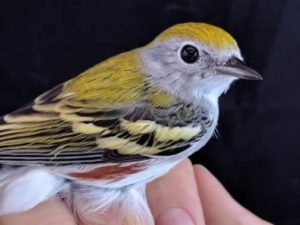 The last two weeks have been phenomenal! Migration has been action packed and there’s been barely a moment to take a breather. Which is great! Our 500
The last two weeks have been phenomenal! Migration has been action packed and there’s been barely a moment to take a breather. Which is great! Our 500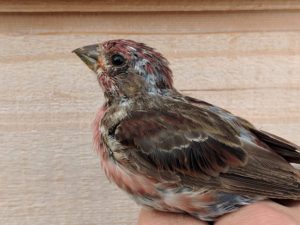 During the last two weeks we caught some rarities for our station. We had our first ever Purple Finch, Brown Thrasher, and Merlin! We have also been lucky enough to catch th
During the last two weeks we caught some rarities for our station. We had our first ever Purple Finch, Brown Thrasher, and Merlin! We have also been lucky enough to catch th In other news, we’ve had a very curious Short-tailed Weasel hanging around. When there are predators in the area we always make sure that the birds are safe. Therefore we have had to close the nets quite a few times because this Weasel is the most confident Weasel out there! Another cool wildlife sighting lately was River Otters! Clayton, one of our volunteers, was lucky enough to spot them and get some great photos!
In other news, we’ve had a very curious Short-tailed Weasel hanging around. When there are predators in the area we always make sure that the birds are safe. Therefore we have had to close the nets quite a few times because this Weasel is the most confident Weasel out there! Another cool wildlife sighting lately was River Otters! Clayton, one of our volunteers, was lucky enough to spot them and get some great photos!
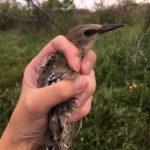 There have been many highlights! It seems almost every day we have a new one. We have already been seeing non-resident warblers making their way south through the marsh. Some seem to be a tad early but that’s okay! We’ve already caught 7 Tennessee Warblers and hopefully we will see them through to September. Of course we have been catching Common Yellowthroats and Yellow Warblers (our resident warblers) Currently Yellow Warblers make up the majority of birds banded at 108.
There have been many highlights! It seems almost every day we have a new one. We have already been seeing non-resident warblers making their way south through the marsh. Some seem to be a tad early but that’s okay! We’ve already caught 7 Tennessee Warblers and hopefully we will see them through to September. Of course we have been catching Common Yellowthroats and Yellow Warblers (our resident warblers) Currently Yellow Warblers make up the majority of birds banded at 108.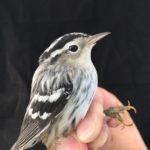
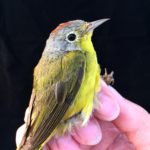 Kelsey was very excited about her first Black and White Warbler and Nashville Warblers banded in the past week.
Kelsey was very excited about her first Black and White Warbler and Nashville Warblers banded in the past week.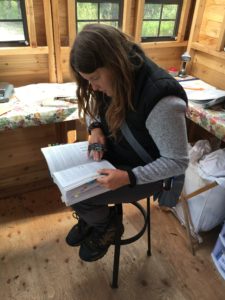 Some of our recent observations have been Sandhill Cranes, many American White Pelicans, Canada Geese have been moving around and making, Catbirds, Eastern Kingbirds, and tons of Wrens. There has also been a young Coyote that has greeted us a couple of mornings, many many toads, and we’ve been lucky enough to catch two Common Green Darners along with some other dragonflies.
Some of our recent observations have been Sandhill Cranes, many American White Pelicans, Canada Geese have been moving around and making, Catbirds, Eastern Kingbirds, and tons of Wrens. There has also been a young Coyote that has greeted us a couple of mornings, many many toads, and we’ve been lucky enough to catch two Common Green Darners along with some other dragonflies.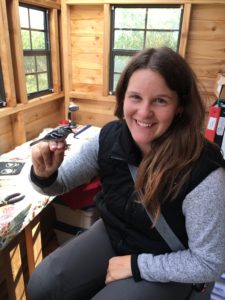 This year’s bander in charge is Kelsey Bell, one of our dedicated volunteers from the last two seasons. She also has banding experience from 3 field seasons banding Grassland birds in Montana and some time banding Fairy Wrens in Australia so she is bringing a ton of knowledge with her. Kelsey will be banding everyday from 30 minutes before sunrise for 6 hours. Weather permitting of course.
This year’s bander in charge is Kelsey Bell, one of our dedicated volunteers from the last two seasons. She also has banding experience from 3 field seasons banding Grassland birds in Montana and some time banding Fairy Wrens in Australia so she is bringing a ton of knowledge with her. Kelsey will be banding everyday from 30 minutes before sunrise for 6 hours. Weather permitting of course. Our brand new banding hut is being put to the Fall Banding test and it is working out fabulously! We are hoping to raise funds towards electrifying the building to keep us (and the birds) warm on those chilly fall or spring mornings. Not only is the hut working well but it looks great too! We are so lucky and grateful to our volunteers that helped us build it.
Our brand new banding hut is being put to the Fall Banding test and it is working out fabulously! We are hoping to raise funds towards electrifying the building to keep us (and the birds) warm on those chilly fall or spring mornings. Not only is the hut working well but it looks great too! We are so lucky and grateful to our volunteers that helped us build it. A big highlight from our first few days included the first ever Mourning Dove banded at DMBO! We’ve been waiting patiently for one of those doves to fly in and it finally happened. A couple other highlights include a Warbling Vireo, American Goldfinch, and Cedar Waxwings. Lucky for us there’s a Cedar Waxwing nest nearby so we will probably be able to get all those babies banded too.
A big highlight from our first few days included the first ever Mourning Dove banded at DMBO! We’ve been waiting patiently for one of those doves to fly in and it finally happened. A couple other highlights include a Warbling Vireo, American Goldfinch, and Cedar Waxwings. Lucky for us there’s a Cedar Waxwing nest nearby so we will probably be able to get all those babies banded too.